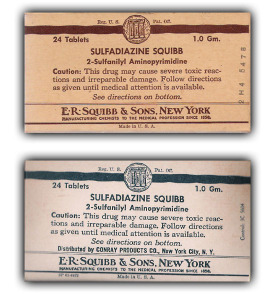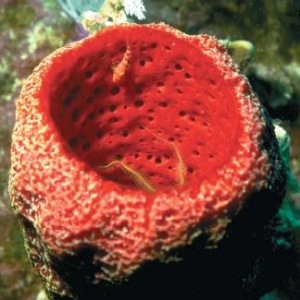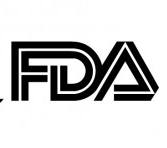The Internet’s full of miracle cures. You could “cure” your cancer, herpes or anything else 100 times over if you spent an hour on YouTube. Then, of course, there’s reality. Reality is good. Let’s talk about reality.
Many don’t even understand why the FDA was founded in the first place. Let’s go back 150-175 years. The world was a mess. Medicine was far more art than science and the public was (shocking as it may seem) vastly more ignorant than they are today, which is saying a lot. Viruses had yet to be discovered and antibiotics had yet to be invented. Scientific knowledge was limited and diseases were rampant. Even the microscope was new and rare.
People had been calling orofacial herpes “cold sores” and “fever blisters” for centuries, because all anyone (including science) knew was that when you had a bad cold or a fever, the sores showed up. Without any other evidence, logic would dictate that the colds and fevers were to blame; thus the names. It wouldn’t be for another 50 years yet that viruses were even confirmed to exist.
Let’s take a little trip back through US medicinal history, from 1828 to the present, so that you can come to understand how and why drug regulation and oversight came to exist.
1828
The U.S. Pharmacopeial Convention was founded in Washington, DC. All state societies of medicine were invited to send delegates—11 doctors attended. USP creates a system of standards, and a national formulary. Only 217 drugs meeting the criteria of “most fully established and best understood” admitted. Dr. Lyman Spalding, Dr. Samuel Mitchill and Dr. Jacob Bigelow credited with establishing the United States Pharmacopeia (USP) compendium.
It’s important to note that it was actually medical practitioners and not the government who decided that coming to mutual agreement upon what was known among their community to be safe and effective was a good thing. So many elixirs and tinctures and syrups were being marketed by those who had no medical knowledge; those patients often ended up at the real doctor’s office with far more trouble than they started with.
1847
Another group was founded in Philadelphia. The American Medical Association was formed to self-regulate medical practitioners, to establish and ensure standards of care and to advise both the public and the government on health.
1848
Upon urging by the AMA, the US government first began regulation. In this case, the inspection by Customs of any imported medicinal products to ensure quality.
During this period and for time immemorial beforehand, tinctures, potions, brews and even magic spells and incantations were all man knew of “medicine”. Regulation didn’t exist. Safety and efficacy weren’t at all necessary and the only limitations to success were one’s ability to market. As long as you could sucker new into believing that your proprietary “Miracle Mouse Pee & Dirty Sock Liniment” would cure their ailments faster than customers came to realize that it actually didn’t, you’d gain wealth. A lot of wealth. Most of these snake oil salesmen traveled in wagons for this very reason. Mobility was key: you could only soak a town for so much money, for so long, before everyone found out that they’d been duped and you’d be wise to be long gone before they did, or there would be hell to pay.
Problem is, a lot of this stuff did a much more than just fail to cure anything. It was poisoning people. However, since medicine technology still had a long way to go, how would one prove what killed a patient: the illness or the medicine? Indeed, it was hard to snare a snake oil man.
1849
The AMA established a board to analyze quack remedies and nostrums and to enlighten the public in regard to the nature and danger of such remedies.
1862
President Abraham Lincoln founded the U.S. Department of Agriculture (USDA), and appointed a chemist, Charles M. Wetherill, to lead USDA’s Division of Chemistry, which did its food and drug investigations.
1883
Dr. Harvey W. Wiley (future father of the FDA) became the chief chemist at the Bureau of Chemistry’s food adulteration studies.
1886
a fellow working in a railway office in Minnesota had a brand new idea. Fate had landed a case of railroad watches in his lap and, with access to the telegraph lines and plenty of railroaders, he sold out in a hurry. Thus, mail order was born (along with what would become Sears, Roebuck & Company) and once the snake oil salesmen got ahold of the mail order concept, business exploded. It allowed one to sit safely in one spot and rip people off across North America without ever having to leave town. Simple don’t sell your snake oil in your own town. Brilliant. If you’re a con man, anyway.
1900
By the turn of the century, the theory of viruses had been confirmed. So, focus turned to that. All the snake oil purported to cure viruses; the newest, scariest scientifically-proven, monster-under-the-bed known to man. Viruses were to blame for everything and various potions, nostrums, liniments and other such snake oil were the cures du jour.
1905
the American Medical Association (AMA) began a voluntary program of drug approval that would last until 1955. In order to advertise in the AMA and related journals, drug companies must show proof that the drug will treat what they claim. Thus, in order to market medicines to doctors, one had to be willing to prove to the doctors that the medicine performed as claimed.
1906
The original Food and Drug Act – forming the Food, Drug, and Insecticide Administration (FDIA) is passed by Congress on June 30 and signed by President Theodore Roosevelt. The Act outlaws states from buying and selling food, drinks, and drugs that have been mislabeled and tainted. (That’s it. Labeling.)
In U.S. v. Johnson, the Supreme Court rules that the 1906 Food and Drugs Act did not outlaw false medical claims but only false and misleading statements about the ingredients or identity of a drug. Obviously, there was much room for improvement in ensuring public safety (both health and financial).
1921
Congress passed the Sherley Amendment to overcome the ruling in U.S. v. Johnson. The Act outlawed labeling medicines with fake medical claims that is meant to trick the buyer.
The name of the Food, Drug, and Insecticide Administration is shortened to Food and Drug Administration (FDA) under an agricultural appropriations act.
1933
The FDA recommends a total rewrite of the out-of-date 1906 Food and Drugs Act, having learned much (and much the hard way) over the past few decades.
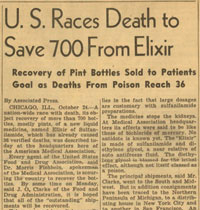 1937
1937
Elixir Sulfanilamide, contain the poisonous liquid, diethylene glycol, kills 107 persons, many of whom are children, dramatizing the need to establish drug safety before marketing and to pass the pending food and drug law.
1938
Congress passes The Federal Food, Drug, and Cosmetic (FDC) Act of 1938, which requires that new drugs show safety before selling. This starts a new system of drug regulation. The Act also requires that safe limits be set for unavoidable poisonous matter and allows for factory inspections.
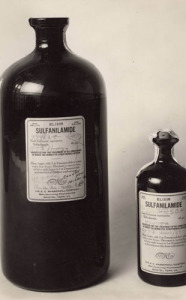 FDA states that sulfanilamide and other dangerous drugs must be given under the direction of a medical expert. The prescription is born. This begins the requirement for prescription only (non- narcotic) drugs (see 1951 Durham-Humphrey amendment).
FDA states that sulfanilamide and other dangerous drugs must be given under the direction of a medical expert. The prescription is born. This begins the requirement for prescription only (non- narcotic) drugs (see 1951 Durham-Humphrey amendment).
The Federal Trade Commission is given power to oversee advertising for all FDA- regulated products except prescription drugs.
1941
Nearly 300 deaths and injuries result from the use of sulfathiazole tablets, an antibiotic, tainted with the sedative, phenobarbital. In response, FDA drastically changes manufacturing and quality controls. These changes lead to the development of good manufacturing practices (GMPs).
1948
The Supreme Court rules in U.S. v. Sullivan that FDA jurisdiction extends to retail stores, thereby allowing FDA to stop illegal sales of drugs by pharmacies including barbiturates and amphetamines.
1950
In Alberty Food Products Co. v. U.S., a U.S. Court of Appeals rules that the directions for use on a drug label must include the drug’s purpose.
1950
Congress passes the Durham-Humphrey Amendment, which defines the kinds of drugs that cannot be used safely without medical supervision. The amendment limits sale of these drugs to prescription only by a medical professional. All other drugs are to be available without a prescription.
1952
A nationwide investigation by FDA reveals that chloramphenicol, an antibiotic, caused nearly 180 cases of often deadly blood diseases. Two years later FDA engages the American Society of Hospital Pharmacists, the American Association of Medical Record Librarians, and later the American Medical Association in a voluntary program of drug reaction reporting.
Go check out that can of Lysol in your bathroom. Read the back of the label. See where it says “Kills herpes”? Disregarding the fact that you can’t kill a virus (they aren’t alive to begin with), there’s a very good reason it’s on your can of bathroom disinfectant: they used to market the same chemical as a feminine hygiene douche. From 1920 to the advent of actual birth control in the 1960’s, Lysol was the #1 birth control agent in the country until enough women had their innards burned out. (to read the full story, click here)
1962
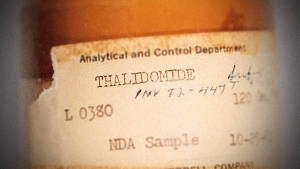 Thalidomide, a new sleeping pill, causes severe birth defects of the arms and legs in thousands of babies born in Western Europe. The U.S. media reports on how Dr. Frances Kelsey, a FDA medical officer, helped prevent approval and marketing of Thalidomide in the United States. These reports stirred up public support for stronger drug laws.
Thalidomide, a new sleeping pill, causes severe birth defects of the arms and legs in thousands of babies born in Western Europe. The U.S. media reports on how Dr. Frances Kelsey, a FDA medical officer, helped prevent approval and marketing of Thalidomide in the United States. These reports stirred up public support for stronger drug laws.
In the same year, congress passed the Kefauver-Harris Drug Amendments. For the first time, these laws require drug makers to prove their drug works before FDA can approve them for sale.
Also in 1962, the Advisory Committee on Investigational Drugs met for the first time. This was the first meeting of a committee to advise FDA on product approval and policy on an ongoing basis.
1966
FDA contracts with the National Academy of Sciences/National Research Council to measure the effectiveness of 4,000 marketed drugs which had been approved on the basis of safety alone between 1938 and 1962.
The Fair Packaging and Labeling Act requires all consumer products, in interstate commerce, to be honestly and informatively labeled.
1968
FDA forms the Drug Efficacy Study Implementation (DESI) to carry out recommendations of the National Academy of Sciences Investigation of the effectiveness of drugs first sold between 1938 and 1962.
1970
FDA requires the first patient package insert, medicines must come with information for the patient about risks and benefits.
1972
Over-the-Counter Drug Review begins to enhance the safety, effectiveness and appropriate labeling of drugs sold without prescription.
1973
The U.S. Supreme Court upholds the 1962 drug effectiveness law and approves FDA’s action to control entire classes of products.
1982
FDA issues Tamper-resistant Packaging Regulations to prevent poisonings such as deaths from cyanide placed in Tylenol capsules. Congress passes the Federal Anti- Tampering Act in 1983, making it a crime to tamper with packaged consumer products.
1984
Drug Price Competition and Patent Term Restoration Act (Hatch-Waxman Act) increases the availability of less costly generic drugs by allowing FDA to approve applications for generic versions of brand-name drugs without repeating the research that proved the safety and effectiveness of the brand-name drugs. The Act also allowed brand-name companies to apply for up to five years additional patent protection for the new medicines they developed to make up for time lost while their products were going through FDA’s approval process.
1989
The FDA issued guidelines asking drug makers to decide if a drug is likely to have usefulness in elderly people and to include elderly people in studies when applicable.
1991
Ten years prior, the FDA and the Department of Health and Human Services published a policy on protecting people in research. In 1991, this policy is adopted by more than a dozen federal agencies involved in human subject research and becomes known as the Common Rule.
1993
FDA launches MedWatch, a system designed to collect reports from health professionals on problems with drugs and other medical products.
FDA issues guidelines for measuring gender differences in responses to medication. Drug companies are encouraged to include patients of both sexes in their research of drugs and to study any gender-specific effects.
1995
FDA declares cigarettes to be “drug delivery devices.” Limits are issued on marketing and sales to reduce smoking by young people.
1998
FDA introduces the Adverse Event Reporting System (AERS), a computerized database designed to store and study safety reports on already marketed drugs.
The Demographic Rule requires that a marketing application review data on safety and effectiveness by age, gender, and race.
The Pediatric Rule requires drug makers of selected new and existing drugs to conduct studies on drug safety and effectiveness in children.
1999
Creation of the Drug Facts Label for OTC drug products. The law requires all over- the-counter drug labels to have information in a standard format. These drug facts labels are designed to give the user easy-to-find information.
2000
The U. S. Supreme Court, upholds an earlier decision from Food and Drug Administration v. Brown & Williamson Tobacco Corp. et al. and rules 5-4 that FDA does not have authority to regulate tobacco as a drug.
2002
The Best Pharmaceuticals for Children Act, in exchange for studying the drug in children, the drug maker gets six months of selling their product without competition.
2003
The Pediatric Research Equity Act gives FDA the right to ask drug companies to study the effectiveness of new drugs in children.
2004
FDA advises medical professionals to limit the use of a pain reliever called Cox-2, a nonsteroidal anti-inflammatory drug (NSAIDs). Studies had shown that long-term use raised chances of heart attacks and strokes. The warning is also added to the over-the- counter NSAIDs’ Drug Facts label.
Medicines used in hospitals must have a bar code to prevent patients from receiving the wrong medicine.
2005
The Drug Safety Board is formed, consisting of FDA staff and representatives from the National Institutes of Health and the Veterans Administration. The Board advises the Director, Center for Drug Evaluation and Research, FDA, on drug safety issues and works with the agency in sharing safety information to health professionals and patients.
After reading the entire story, can anyone honestly say, with any conviction, that the AMA and the FDA have not been diligent in working to protect the people of the United States, not only from snake oil salesmen, but from their own naivety and ignorance, both financially and medically?
It took a long time, but any product in the US claiming to actually “cure” anything must now be proven both safe and effective, including individual demographic groups, before being sold within the United States, for reasons which should be quite obvious after reading all the above. Perfectly legitimate reasons – not to stifle cures, but to keep you from harming yourself and to keep others from harming you. A system (VAERS) is also in place to track any and all complaints about any approved drug. Forever. This system is constantly monitored to look for any commonalities – any “red flags” – which might indicate that more research is necessary in regard to the flag and that research is then performed.
Today, the Internet is rife with snake oil salesmen peddling the “cures” with headlines which claim “the government doesn’t want you to know about” or “big pharma doesn’t want you to hear about.” Trust us on this: “big pharma” likes money a whole lot and they have a whole lot of money to spend on sourcing potential cures, anywhere on the globe, which would bring them a whole lot more money. There are thousands, if not millions out there who would be most happy to lie to you for a few bucks, selling you everything from industrial bleach to sawdust pellets and promising to fix your problems. If any of that stuff worked worth a darn, “big pharma” would already have proven it to the FDA and be selling it to you for $100 a bottle and yes, you actually can patent a common chemical/substance (for a specific purpose).
There’s no law stopping them from utilizing goji berries, acai, seaweed, coconut oil, ionized silver or any of the other exotic nonsense you see out there. You know what actually does keep them from doing it? They don’t work. This stuff has already proven not to work, in actual research, with real science! When something actually is found promising, they prove it and they use it. Meet your Valtrex (see photo). It’s a sea sponge, not some “industrial chemical”. Most medicines are derived from the very sources often thought of as natural and herbal. Legitimate pharmaceutical companies go the extra mile, proving they’re safe and they work and refining them in order to maximize results; to eliminate unnecessary (and sometime toxic) ingredients; to better guarantee safety and effectiveness.
You see, a pharma company can’t sell you garbage and poison and just shut down their website when the heat is on, like your friendly neighborhood Internet snake oil salesmen. They actually have to stay put, do the sourcing, do the formulating, do the research , do the clinical trials and, if they manage to do all of that – at a an average development cost of $1.2 billion dollars per drug – then they receive approval and can begin marketing and selling it, with all the regulations in place… and both the pharma and the FDA continuously research any reports of effects for the market-life of the drug. Monitoring never ends.
Now, we all have to ask ourselves, “Am I foolish enough to play sucker and let some snake oil salesmen rob me and/or poison me, or should I trust the system that’s been developed and refined for nearly 200 years to keep me safe?”
And, if you think vitamins and supplements are somehow better or safer than pharmaceuticals, think again. This category consists of the stuff that has not proven to do anything at all. It’s unregulated. That vitamin or supplement you buy may contain 1% of the ingredient it claims, or 100%. It may vary from pill to pill; it may vary from bottle to bottle; the substance may or may not do what the label implies or claims. No guarantees. And yes, sawdust is sometimes a filler. Fortunately, the FDA may take steps soon to begin demanding quality assurance, at least, from these manufacturers in order to guarantee that you’re actually being sold the ingredients you’re paying for. Much like the FDA drug regulation history we read earlier, though, ensuring both safety and effectiveness of supplements will require extra steps/regulations.
Below are but a few safety reports and warnings of popular fake miracle cures/treatments and snake oil that are going around on the Internet:
About that “Food Grade” hydrogen peroxide…
Do you know what “food grade” actually means? It means you can use it to kill every living thing on produce, but it must then be washed off completely before consumption. It’s got nothing to do with ingesting the H202 itself – ever – in any concentration. Sure it’ll kill whatever’s living on your lettuce; it’ll kill you, too, if you drink too much or screw up your little dilution self-experiment (or your kid, when they find the bottle and drink it.) What it cannot do, though, is have any effect whatsoever on HSV. The science doesn’t work that way. It’d kill you long before you could possibly reach a concentration anywhere near high enough to have any effect on the HSV within your cells.
This should be fairly obvious, since it would have to destroy your cells in order to even get at the HSV within. There has never been any proof of any benefit for the oral ingestion of H202 into the human body. There’s plenty of proof, however, that it does some serious damage when ingested. Sure, you can dilute it. You can drink diluted chlorine bleach or gasoline, too, and if diluted enough it wouldn’t kill you (not right away). One thing’s for certain, however: none of them is going to help you in any way. If H202 actually had any positive effect, “big pharma” would already be selling it to you and – as previously mentioned – you actually can patent a common product for a specific purpose (so don’t buy that excuse when they give it.)
FDA Warns Consumers Against Drinking High-Strength Hydrogen Peroxide for Medicinal Use: Ingestion Can Lead to Serious Health Risks and Death
Miracle Mineral Solution (MMS): Product as consumed produces a potent bleach
We’re not sure how anyone actually falls for this stuff, but many do. Would you drink bleach? We didn’t think so. Then why on earth would you even consider drinking something that becomes industrial bleach in your digestive tract? You’d have to be suicidal or stupid to think that was actually a good idea. You’ve got gut bacteria in your digestive tact, without which you will be one very, very sick person. They’re supposed to be there. Giving them a bleach bath is an incredibly unwise thing to do. It’s not at all good for you, either. It’d never do a thing to your HSV anyway, so don’t mess with it.
Over-the-Counter Drug Products Containing Colloidal Silver Ingredients or Silver Salts
Colloidal Silve: National Center for Complementary & Alternative Medicine
Taken orally, colloidal Silver has never shown to do anything but turn people a nasty shade of blue.
Science has proven none of that stuff works. Ask these people who make their miracle cure claims, “Where’s your research proving it works?” Not a bunch of loosely-related garbage, passed off as substantive research on the top. That’s a diversion. We mean actual published research pertaining directly to the claim. To be honest, you or I could publish a paper tomorrow. The reason they don’t publish research related to their claims is because they would get shot full of holes by those who actually do know what they’re talking about. A snake oil man can’t hold his own in a room full of scientists. All he can do is hope to make you believe that someone is keeping this “cure” secret from you. Ironically, it’s often blamed upon the very agency created to protect you from his lies: the FDA.
If you’ve been getting drawn in by all this secret cure stuff on the Internet, we have a bit of advice for you. Knock it off. When there’s an actual cure for herpes, it won’t be “hidden” by big pharma, the FDA or anyone else. It’ll be on the front page of every paper and magazine and certainly be in our newsletter… and you can bet that “big pharma” will be most anxious to get it approved and sell it. Their income off that one drug alone could rival the GNP of half the countries on earth. Many times more than if they could somehow corner the market on every known treatment today, from antivirals to creams. Whoever owns it will make Bill Gates look like a punk. There’s a very good reason they’re investing billions trying to find the cure: the payoff will be enormous.
As for the FDA, they’ve been protecting Americans at every turn and will continue to do so into the distant future.
For a very nice, complete visual timeline of drug regulation history in the united States, click here.
We hope you found this post helpful. We could use your help, too. Please donate today.
ProjectAccept.org is a Registered 501(c)(3) Non-Profit Corporation.
[Protecting people from their own poor judgment for over 100 years.]






